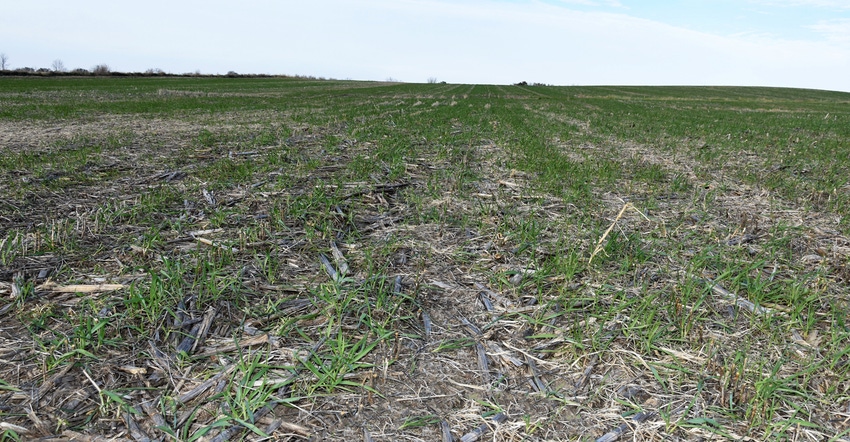April 12, 2019

Iowa State University research suggests cereal rye should be terminated at least 10 to 14 days before planting corn. As the calendar moves into mid-April, some farmers will begin terminating overwintered cover crops if the weather forecast is favorable.
Herbicides provide the most flexibility and consistency in cover crop termination, but they do not come without risks. Cover crops generally have a dense canopy of rapidly growing plants in the spring. That characteristic, combined with cool temperatures typical of this time of year, leaves the door open for termination failure.
To help farmers achieve effective termination of cover crops, Iowa State University Extension weed management specialist Bob Hartzler, along with ISU Extension field agronomist Meaghan Anderson, offer the following guidelines and observations.
They point out that herbicide choices for spring cover crop termination are relatively few, and limited information is available to determine the effectiveness of burndown treatments on the less common cover crop species.
Some covers harder to control
Kevin Bradley, University of Missouri Extension weed control specialist, has found that hairy vetch, cereal rye and Austrian winter pea are relatively easy to control with herbicides. Other species, including annual ryegrass, wheat and crimson clover, are more difficult. Information on Bradley’s research is on the MU website.
Glyphosate provides the most consistent control of grass cover crops, but paraquat may work in certain situations. Glyphosate generally provides more consistent control in early spring under variable weather conditions than paraquat. Neither Group 10 (glufosinate/Liberty) nor Group 1 (Assure II, Select, etc.) herbicides have provided consistent control of cereal rye.
Plan spring spraying program
If you have less-than-ideal weather conditions, that can inhibit herbicide effectiveness. The following tips may help when planning your spring sprays.
1. Know when to spray. Whenever possible, spray midday in sunny conditions when daytime temperatures are above 60 degrees F, the cover crop is actively growing, and nighttime temperatures will be above 40 degrees.
2. Don’t be stingy. Avoid skimping on herbicide or adjuvant rates during the cool spring conditions typically encountered during cover crop termination. Glyphosate at 1 pound acid equivalent per acre with AMS-treated water is suggested for best control of cereal rye; other species, like annual ryegrass, may require higher glyphosate rates.
3. Read the label. Follow herbicide label instructions for appropriate adjuvants to use and mixing order. Pay attention to application instructions, including spray volume, nozzle type and environmental considerations. Increased spray volumes (15 to 20 gallons per acre) may help improve coverage in dense canopies.
4. Be mindful of mixing. The use of off-label adjuvants and inclusion of additional herbicides may reduce the effectiveness of the spray. Antagonism is sometimes observed with certain tank-mixes or termination timings but not others, so consulting the available research may be useful.
5. Watch for restrictions. Check herbicide labels for restrictions to planting corn or soybeans following application. Follow the label recommendations to avoid injury to your cash crop.
Resources
More resources on terminating rye ahead of corn:
Source: ISU, which is responsible for information provided and is wholly owned by the source. Informa Business Media and its subsidiaries aren’t responsible for any of the content contained in this information asset.
You May Also Like




